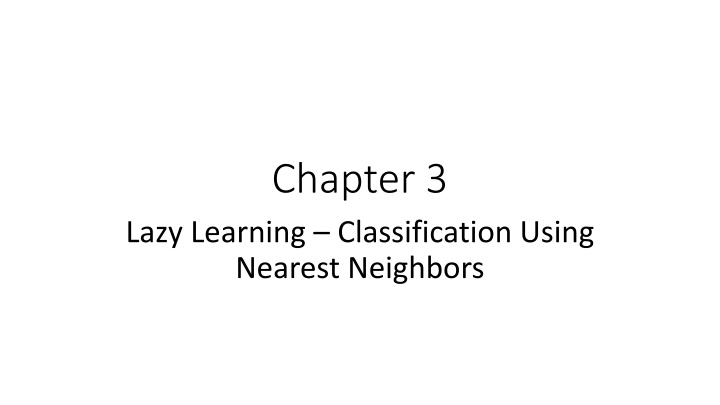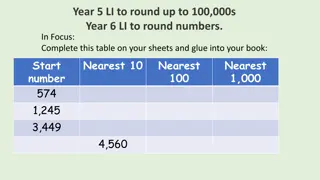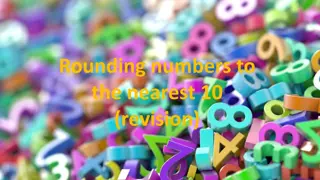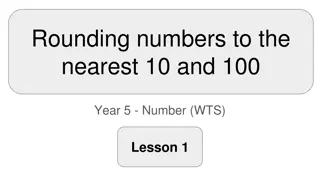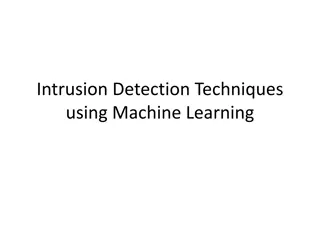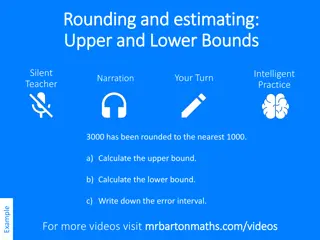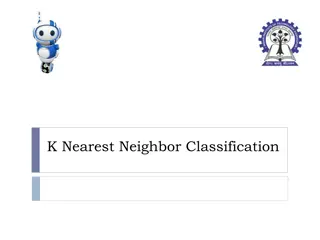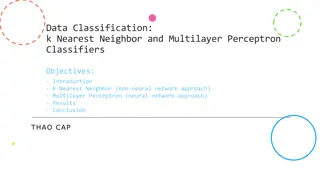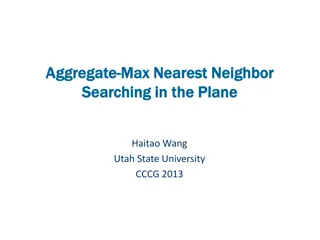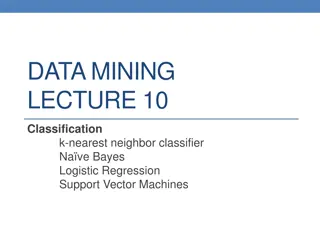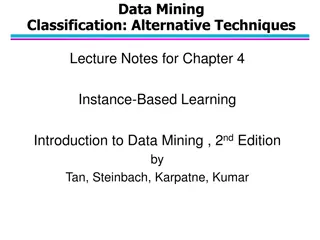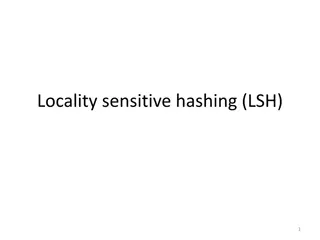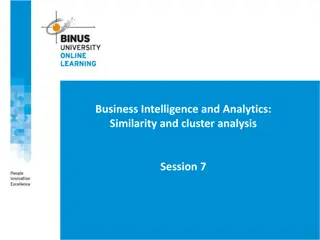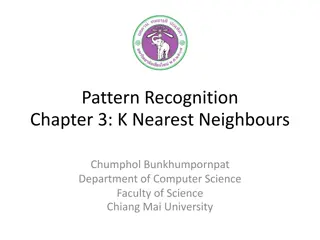Lazy Learning Classification Using Nearest Neighbors
Lazy Learning Classification Using Nearest Neighbors explores the concept of classifying data by grouping it with similar neighbors. The chapter delves into the characteristics of nearest neighbor classifiers, their applications in various fields, and the suitability of using them based on data complexity. It also introduces the k-NN algorithm, outlining its strengths and weaknesses in machine learning applications.
Download Presentation

Please find below an Image/Link to download the presentation.
The content on the website is provided AS IS for your information and personal use only. It may not be sold, licensed, or shared on other websites without obtaining consent from the author.If you encounter any issues during the download, it is possible that the publisher has removed the file from their server.
You are allowed to download the files provided on this website for personal or commercial use, subject to the condition that they are used lawfully. All files are the property of their respective owners.
The content on the website is provided AS IS for your information and personal use only. It may not be sold, licensed, or shared on other websites without obtaining consent from the author.
E N D
Presentation Transcript
Chapter 3 Lazy Learning Classification Using Nearest Neighbors
The approach An adage: if it smells like a duck and tastes like a duck, then you are probably eating duck. A maxim: birds of a feather flock together. The idea: things that are alike are likely to have properties that are alike. The principle for machine learning: classify data by placing it in the same category as similar or nearest neighbors.
Topics of this chapter The key concepts that define nearest neighbor classifiers, and why they are considered "lazy" learners Methods to measure the similarity of two examples using distance To apply a popular nearest neighbor classifier called k-NN
Understanding nearest neighbor classification Understanding nearest neighbor classification nearest neighbor classifiers are defined by their characteristic of classifying unlabeled examples by assigning them the class of similar labeled examples. nearest neighbor methods are extremely powerful. They have been used successfully for: Computer vision applications, including optical character recognition and facial recognition in both still images and video Predicting whether a person will enjoy a movie or music recommendation Identifying patterns in genetic data, perhaps to use them in detecting specific proteins or diseases
Suited and unsuited areas Suited: relationships among the features and the target classes are numerous, complicated, or extremely difficult to understand, yet the items of similar class type tend to be fairly homogeneous. Or, if a concept is difficult to define, but you know it when you see it, then nearest neighbors might be appropriate. Unsuited: if the data is noisy and thus no clear distinction exists among the groups, the nearest neighbor algorithms may struggle to identify the class boundaries.
The k The k- -NN algorithm NN algorithm k-nearest neighbors algorithm (k-NN). one of the simplest machine learning algorithms used widely strengths and weaknesses Strengths: Simple and effective Makes no assumptions about the underlying data distribution Fast training phase Weaknesses: Does not produce a model, limiting the ability to understand how the features are related to the class Requires selection of an appropriate k Slow classification phase Nominal features and missing data require additional processing
The process uses information about an example's k-nearest neighbors to classify unlabeled examples k is a variable term implying that any number of nearest neighbors could be used the algorithm requires a training dataset made up of examples that have been classified into several categories, as labeled by a nominal variable For each unlabeled record in the test dataset, k-NN identifies k records in the training data that are the "nearest" in similarity. The unlabeled test instance is assigned the class of the majority of the k nearest neighbors.
Blind tasting experience To classify ingredients rate two features of each ingredient: Crunchiness (1-10) Sweetness (1-10) label each ingredient as one of the three types of food: fruits, vegetables, or proteins
Feature space The k-NN algorithm treats the features as coordinates in a multidimensional feature space. Ingredient's dataset: scatter plot
The pattern Similar types of food tend to be grouped closely together. vegetables tend to be crunchy but not sweet Fruits tend to be sweet and either crunchy or not crunchy proteins tend to be neither crunchy nor sweet
Measuring similarity with distance Measuring similarity with distance distance function - a formula that measures the similarity between the two instances Euclidean distance the shortest direct route, measured "as the crow flies Traditionally used by R Manhattan distance - based on the paths a pedestrian would take by walking city blocks
Euclidean distance p and q - examples to be compared, each having n features E.g., distance between the tomato (sweetness = 6, crunchiness = 4), and the green bean (sweetness = 3, crunchiness = 7): distance between the tomato and several of its closest neighbors
Classification of tomato 1-NN classification: assigning the tomato, the food type of its single nearest neighbor, orange - tomato is a fruit. k-NN algorithm with k = 3: performs a vote among the three nearest neighbors: orange, grape, and nuts - tomato is a fruit.
Choosing an appropriate k Choosing an appropriate k bias-variance tradeoff - balance between overfitting and underfitting the training data large k: reduces the impact or variance caused by noisy data bias the learner so that it runs the risk of ignoring small, but important patterns extreme stance: k, as large as the total number of observations in the training data every training instance is represented in the final vote the most common class always has a majority of the voters The model would always predict the majority class, regardless of the nearest neighbors
The opposite extreme using a single nearest neighbor: noisy data or outliers can unduly influence the classification of examples Any unlabeled example that happens to be nearest to the incorrectly labeled neighbor will be predicted to have the incorrect class The best k value is somewhere between these two extremes choosing k depends on: difficulty of the concept to be learned number of records in the training data One common practice is to begin with k equal to the square root of the number of training examples E.g., k = 4 because there were 15 example ingredients in the training data
Decision boundary Smaller values of k allow more complex decision boundaries that more carefully fit the training data
Choosing k rules may not always result in the single best k Alternative approach is to test several k values on a variety of test datasets a large training dataset can make the choice of k less important even subtle concepts will have a sufficiently large pool of examples to vote as nearest neighbors A less common solution: choose a larger k, but apply a weighted voting process in which the vote of the closer neighbors is considered more authoritative than the vote of the far away neighbors
Preparing data for use with k Preparing data for use with k- -NN NN Features are typically transformed to a standard range prior to applying the k-NN algorithm Distance formula is highly dependent on how features are measured: if certain features have a much larger range of values than the others, the distance measurements will be strongly dominated by the features with larger ranges Solution is to rescale the features by shrinking or expanding their range such that each one contributes relatively equally to the distance formula
min min- -max normalization max normalization traditional method of rescaling features for k-NN transforms a feature such that all of its values fall in a range between 0 and 1 Normalized feature values can be interpreted as indicating how far, from 0 percent to 100 percent, the original value fell along the range between the original minimum and maximum
z z- -score standardization score standardization z-score: how many standard deviations the feature's values fall above or below the mean value. z-scores fall in an unbound range of negative and positive numbers Issue with min-max normalization: the minimum or maximum of future cases might be outside the range of values observed in the training data Issue with z-score standardization: future examples may not have similar mean and standard deviation as the training examples
Distance between nominal features Euclidean distance formula is not defined for nominal data Dummy coding: a value of 1 indicates one category, and 0, the other E.g., dummy coding for a gender variable n-category nominal feature can be dummy coded by creating the binary indicator variables for (n - 1) levels of the feature E.g., dummy coding for a three-category temperature variable (for example, hot, medium, or cold) could be set up as (3 - 1) = 2 features
Distance between dummy coded features Distance between dummy coded features is always one or zero, no additional transformation is necessary. An alternative to dummy coding for ordinal nominal features: number the categories and apply normalization E.g., cold, warm, and hot could be numbered as 1, 2, and 3, which normalizes to 0, 0.5, and 1. Caveat: this approach should only be used if the steps between the categories are equivalent. E.g., steps between groups of poor, middle class, and wealthy are not equal
Why is the k Why is the k- -NN algorithm lazy? NN algorithm lazy? lazy learning - no abstraction occurs, abstraction and generalization processes are skipped altogether Under the strict definition of learning, a lazy learner is not really learning anything merely stores the training data verbatim training phase can be done very rapidly process of making predictions tends to be relatively slow in comparison to training instance-based learning or rote learning: heavy reliance on the training instances rather than an abstracted model
Non Non- -parametric parametric learning methods no parameters are learned about the data allows the learner to find natural patterns rather than trying to fit the data into a preconceived and potentially biased functional form
Example Example diagnosing breast cancer with the k diagnosing breast cancer with the k- -NN algorithm NN algorithm Detecting cancer by applying the k-NN algorithm to measurements of biopsied cells from women with abnormal breast masses Step 1 collecting data Wisconsin Breast Cancer Diagnostic dataset from the UCI Machine Learning Repository at http://archive.ics.uci.edu/ml donated by researchers of the University of Wisconsin includes the measurements from digitized images of fine-needle aspirate of a breast mass values represent the characteristics of the cell nuclei present in the digital image
The dataset 569 examples of cancer biopsies 32 features identification number cancer diagnosis - "M" to indicate malignant or "B" to indicate benign 30 numeric-valued laboratory measurements - mean, standard error, and worst (that is, largest) value for 10 different characteristics of the digitized cell nuclei Radius Texture Perimeter Area Smoothness Compactness Concavity Concave points Symmetry Fractal dimension
Step 2 Step 2 exploring and preparing the data exploring and preparing the data Download the wisc_bc_data.csv file from the Packt website a header line was added rows of data were randomly ordered Importing the CSV data file: > wbcd <- read.csv("wisc_bc_data.csv", stringsAsFactors = FALSE) > str(wbcd)
Exclude ID ID variables should always be excluded Neglecting to do so can lead to erroneous findings ID can be used to uniquely "predict" each example A model that includes an identifier will suffer from overfitting Exclude ID (first column) > wbcd <- wbcd[-1] Target feature diagnosis > table(wbcd$diagnosis) B M 357 212
target feature as a factor Many R machine learning classifiers require that the target feature is coded as a factor > wbcd$diagnosis<- factor(wbcd$diagnosis, levels = c("B", "M"), labels = c("Benign", "Malignant")) > round(prop.table(table(wbcd$diagnosis)) * 100, digits = 1) Benign Malignant 62.7 37.3
30 numeric features Observation: Normalization is needed!
Transformation Transformation normalizing numeric data normalizing numeric data create a normalize() function in R: > normalize <- function(x) { return ((x - min(x)) / (max(x) - min(x))) } test the function: > normalize(c(1, 2, 3, 4, 5)) [1] 0.00 0.25 0.50 0.75 1.00 > normalize(c(10, 20, 30, 40, 50)) [1] 0.00 0.25 0.50 0.75 1.00
lapply() function lapply() function takes a list and applies a specified function to each list element > wbcd_n <- as.data.frame(lapply(wbcd[2:31], normalize)) confirm the correctness of the transformation
Data preparation Data preparation creating training and test datasets creating training and test datasets simulate the scenario of applying trained model to unlabeled dataset divide the data into two portions: a training dataset to build the k-NN model: the first 469 records a test dataset to estimate the predictive accuracy of the model: the remaining 100 records > wbcd_train <- wbcd_n[1:469, ] > wbcd_test <- wbcd_n[470:569, ] Store class labels in factor vectors: > wbcd_train_labels <- wbcd[1:469, 1] > wbcd_test_labels <- wbcd[470:569, 1]
Step 3 Step 3 training a model on the data training a model on the data training a lazy learner like k-NN simply involves storing the input data in a structured format the class package > install.packages("class") > library(class) The knn() function in the class package: a standard, classic implementation of the k-NN algorithm using Euclidean distance classification by taking a "vote" among the k-Nearest Neighbors A tie vote is broken at random
apply the k-NN algorithm try k = 21 training data includes 469 instances With a two-category outcome, using an odd number eliminates the chance of ending with a tie vote > wbcd_test_pred <- knn(train = wbcd_train, test = wbcd_test, cl = wbcd_train_labels, k = 21)
Step 4 Step 4 evaluating model performance evaluating model performance > CrossTable(x = wbcd_test_labels, y = wbcd_test_pred, prop.chisq=FALSE)
Four categories true negative results: top-left cell 61% true positive results: bottom-right cell 37% false negative results: lower-left cell 2% Errors in this direction could be extremely costly - lead a patient to believe that she is cancer-free, but in reality, the disease may continue to spread false positive results: top-right cell 0% less dangerous than a false negative result lead to additional financial burden on the health care system
Step 5 Step 5 improving model performance improving model performance Two simple variations on our previous classifier: alternative method for rescaling our numeric features several different values for k Transformation z-score standardization scale() function: rescales values using the z-score standardization can be applied directly to a data frame > wbcd_z <- as.data.frame(scale(wbcd[-1])) rescales all the features, with the exception of diagnosis confirm the correctness of the transformation
Divide the data into training and test sets > wbcd_train <- wbcd_z[1:469, ] > wbcd_test <- wbcd_z[470:569, ] > wbcd_train_labels <- wbcd[1:469, 1] > wbcd_test_labels <- wbcd[470:569, 1] > wbcd_test_pred <- knn(train = wbcd_train, test = wbcd_test, cl = wbcd_train_labels, k = 21)
Analyze results > CrossTable(x = wbcd_test_labels, y = wbcd_test_pred, prop.chisq = FALSE) 5% false negative rate - worse
Testing alternative values of k Testing alternative values of k It would be unwise to tailor our approach too closely to our test data To be certain that a learner will generalize to future data, create several sets of 100 patients at random and repeatedly retest the result
